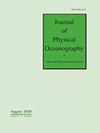What causes the subsurface velocity maximum of the East Australian Current?
IF 3
2区 地球科学
Q1 OCEANOGRAPHY
引用次数: 0
Abstract
The East Australian Current (EAC) system includes a poleward jet that flows adjacent to the continental shelf, a southward and eastward extension, and a complex eddy field. The EAC jet is often observed to be subsurface-intensified. Here, we explain that there are two factors that cause the EAC to develop a subsurface maximum. First, the EAC flows as a narrow current, carrying low-density water from the Coral Sea into the denser waters of the Tasman Sea. This results in horizontal density gradients with a different sign on either side of the jet, negative onshore and positive offshore. According to the thermal wind relation, this produces vertical gradients in southward current that are surface-intensified onshore, and subsurface-intensified offshore. Second, we show that the winds over the shelf are mostly downwelling favourable, drawing the surface EAC waters onshore. This aligns the region of positive horizontal density gradients with the EAC core, producing a subsurface velocity maximum. The presence of a subsurface maximum may produce baroclinic instabilities that play a role in eddy formation and EAC separation from the coast.是什么原因导致东澳大利亚洋流的次表层速度最大化?
东澳大利亚洋流(EAC)系统包括邻近大陆架流动的极向喷流、向南和向东的延伸以及复杂的涡场。人们经常观察到东澳洋流的喷流在次表层加强。在此,我们解释了导致 EAC 形成次表层最大值的两个因素。首先,EAC 以窄流形式流动,将珊瑚海的低密度海水带入塔斯曼海的高密度海水中。这导致喷流两侧的水平密度梯度符号不同,岸上为负,离岸为正。根据热风关系,这就产生了南向洋流的垂直梯度,在陆上是表层强化,在近海是次表层强化。其次,我们表明陆架上的风主要是顺流风,将东亚大陆架表层水流引向陆地。这就使正水平密度梯度区域与东亚大陆架核心区域相一致,产生了一个次表层速度最大值。次表层最大速度的出现可能会产生气压不稳定性,在涡流形成和东亚大陆架脱离海岸过程中发挥作用。
本文章由计算机程序翻译,如有差异,请以英文原文为准。
求助全文
约1分钟内获得全文
求助全文
来源期刊
CiteScore
2.40
自引率
20.00%
发文量
200
审稿时长
4.5 months
期刊介绍:
The Journal of Physical Oceanography (JPO) (ISSN: 0022-3670; eISSN: 1520-0485) publishes research related to the physics of the ocean and to processes operating at its boundaries. Observational, theoretical, and modeling studies are all welcome, especially those that focus on elucidating specific physical processes. Papers that investigate interactions with other components of the Earth system (e.g., ocean–atmosphere, physical–biological, and physical–chemical interactions) as well as studies of other fluid systems (e.g., lakes and laboratory tanks) are also invited, as long as their focus is on understanding the ocean or its role in the Earth system.

 求助内容:
求助内容: 应助结果提醒方式:
应助结果提醒方式:


